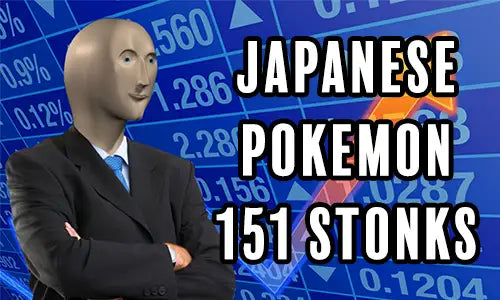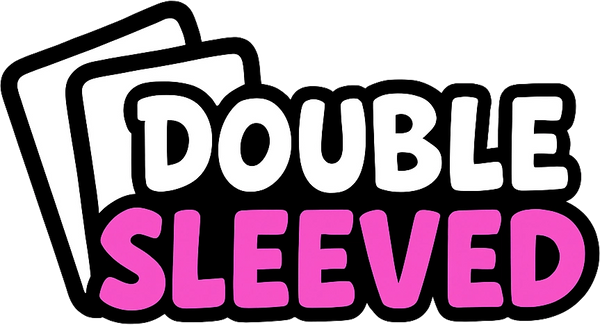How to calculate the expected value of a Japanese Pokemon 151 Booster Box

5 minute read
With the price of a box of Japanese Pokemon 151 skyrocketing after release, are the contents of the box actually worth the hefty price tag? Let's take an in depth and mathematical look to find out.
Table of Contents
So, what is expected value?
Before we get stuck into the numbers and calculations, it is important to debunk some of the misconceptions when talking about the value of a product. Too often we see content creators crack a few packs or even a few boxes and then proclaim a product to be amazing value or terrible value based on the result of their opening. Of course, the mistake being made here is one to do with sample size! The expected value of a product cannot be determined by cracking a few, or even many, boxes, but by calculating the theoretical value of a box's contents based on the known pull rates.
The key idea is that you will almost certainly be above or below expected value if you open 3, 5, or 20 boxes, but as your sample size increases, you iron out the variance and approach the true expected value. Just how many boxes required to get close to the true expected value will depend on factors such as the distribution of value across the set. Is all the value in a single chase card? If so, then expect some huge sample sizes before things even out.

We see small creators all the way to the biggest content creators on the planet, either failing to grasp this concept, or avoiding it altogether for the interest of entertainment and making (untrue) clickbait-y statements.
Expected value is just that - the average value of a typical box. This is not to say every single box opened will have exactly this value of cards inside. Some boxes will have below the expected value, and some boxes above the expected value. This variation of values above and below the average is part of the fun of opening a box and trying to pull the biggest hits - call it the gambler’s premium.
Below, we will break down how to work out the expected value of any product for yourself if you know the pull rates involved.

Facts on the Japanese 151 pull rates
Let’s start with the facts.
A regular Japanese Pokemon 151 booster pack contains 7 cards. If we consider each card as a slot in the pack, we can break it down as follows:
Slot 1 - non-foil common
Slot 2 - non-foil common
Slot 3 - non-foil common
Slot 4 - AR, Reverse Holo, or Master Ball Reverse Holo
Slot 5 - R, RR, SR, SAR, or UR
Slot 6 - non-foil uncommon
-
Slot 7 - non-foil uncommon
However, Japanese Pokemon 151 also features the ever exciting God Pack. These packs can be broken down as follows:
Slot 1 - non-foil common
Slot 2 - AR
Slot 3 - AR
Slot 4 - AR
Slot 5 - AR
Slot 6 - SAR
-
Slot 7 - SAR
The caveat here is that the AR/SAR cards have to be pulled from 2 of the 3 starter evolution lines. That is to say, 2 out of the following 3 options will appear in a God Pack:
Charmander AR, Charmeleon AR, Charizard SAR
Squirtle AR, Wortortle AR, Blastoise SAR
Bulbasaur AR, Ivysaur AR, Venusaur SAR
Assumptions on the Japanese 151 pull rates
Now, for the assumptions. As only a rough estimate of the pull rates for each rarity have been provided by The Pokemon Company, we cannot be 100% certain the following table is accurate, but it is what we will use to calculate our results.
| Card Type | Frequency (Packs) | Decimal Frequency |
| UR | 1/240 | 0.0042 |
| SAR | 1/120 | 0.0083 |
| SR | 1.5/20 | 0.075 |
| AR | 3/20 | 0.15 |
| RR | 4/20 | 0.20 |
| R | 14.25/20 | 0.7125 |
| Pack Type | Frequency | Decimal Frequency |
| God Pack | 1/700 | 0.0014 |
| Regular Pack | 699/700 | 0.9986 |
Calculating expected value

So, from the above section we have established that of the 7 Slots in each regular booster pack, 5 are filled with valueless commons and uncommons, leaving only 2 Slots of interest.
Slot 4 has the potential for a Reverse Holo, Master Ball Reverse Holo, or an AR card. From the known and assumed pull rates, we can calculate the likelihood of each option appearing in this Slot. With an assumed 3 AR cards per box and 1 Master Ball Reverse, we can assume there will be 16 regular Reverse Holos to fill in the blanks.
Once this is known, the rest is a simple, if not arduous, calculation. By this, we mean finding the average value of an AR card, the average value of a Reverse Holo card, and the average value of a Master Ball Reverse Holo card. With 153 possible Reverse and Master Ball Reverse Holos, this can take some time!
For our calculations, we opted for the lowest price for each card on Cardmarket apart from the Master Ball Reverses for which there was not enough data. For those, we used the Ebay last sold price and then converted to Euros for a consistent currency of measure. From this data, we got the following results:
| Card Type | Average Value (EUR) | Frequency | Expected Value (EUR) |
| AR | 7.67 | 0.15 | 1.151 |
| Reverse Holo | 0.89 | 0.8 | 0.712 |
| Master Ball | 23.38 | 0.05 | 1.169 |
| Total | 1 | 3.032 |
The Expected Value column is calculated simply by multiplying the Average Value by the Frequency. Once we sum up the expected value of each card type we can see that Slot 4 in the booster pack offers up €3.03 in expected value.
We can now apply the same methodology to the next slot of interest - Slot 5, or the Rare Slot.
| Card Type | Average Value (EUR) | Frequency | Expected Value (EUR) |
| UR | 36.17 | 0.0042 | 0.151 |
| SAR | 148 | 0.0083 | 1.233 |
| SR | 23.65 | 0.075 | 1.774 |
| RR | 1.20 | 0.2 | 0.24 |
| R | 0.19 | 0.7125 | 0.135 |
| Total | 1 | 3.533 |
This gives us a Slot 5 EV of €3.53. Adding Slot 4 and Slot 5 together, we get a grand total of €6.56 in expected value for a regular booster pack. Whether we assign any negligible value to the common and uncommon slots is a choice we can take here. For simplicity's sake we will opt against it.
Normally, we would just multiple this number by 20 for our box EV, but the dastardly God Packs mean we have to do a few more sums! To find the box EV, we first need to find the average value of a God Pack. Similar to the previous calculations, we must work out the value of each evolution line and then multiply by the frequency of which it occurs.
| Evolution Line | Total Value (EUR) | Frequency | Expected Value (EUR) |
| Blastoise | 81.80 | 0.667 | 54.53 |
| Charizard | 199.74 | 0.667 | 133.16 |
| Venusaur | 94.89 | 0.667 | 63.26 |
| Total | 2 | 250.95 |
This means the expected value of a God Pack is a whopping €250.95! Now, with the EV of both pack types figured out, all we have to do is calculate the value of the average pack. The average pack does not exist in reality and has a chance of becoming a God Pack or a Regular Pack upon opening. Schrodinger's Pack, if you will!
| Pack Type | Expected Value (EUR) | Frequency | Weighted Expected Value (EUR) |
| God Pack | 250.95 | 0.0014 | 0.3585 |
| Regular Pack | 6.56 | 0.9986 | 6.5553 |
| Total | 1 | 6.9138 |
There we have it. An expected value of €6.91 per Japanese 151 booster pack. Multiplying this by 20 gives us a final booster box EV of €138.20! If the value of the cards inside a box drastically outweighs the cost of buying a box, the market corrects itself through savvy groups or individuals who can then arbitrage the difference by doing mass box openings until the prices rebalance.
The booster box EV of €138.20 is a fair chunk below the current market price of a sealed box which sits at around €180, but that is where the gambler's premium comes in. After all, what value can we put on the priceless joy of cracking a box of Pokemon 151?
We hope you found this article insightful and not too much of a bore! If you did then we'd appreciate it if you check out our other articles and expert product reviews here.




